
DID CHOPIN QUOTE
HIS PREDECESSORS?
Beethoven
is reported to have found the character
of Don Giovanni in Mozart’s
eponymous opera repulsive. This
position derived from a view of
art that was based on a firm conviction
about its religious connotations,
as Dr. James H. Johnson points out
in his excellent article Sincerity
and Seduction in Don Giovanni¹.
Yet, consciously or unconsciously,
in the first movement of the Sonata
in c-sharp minor, Op. 27, no. 2 Beethoven
seems to refer very closely to one
of the central elements of Mozart’s
masterpiece: the First Act’s
murder scene, the beginning of a
turbulent series of events that lead
to Don Giovanni’s death.
The moon
is high. Don Giovanni breaks into
the house of the Commendatore with
the goal of adding his daughter,
Donna Anna, to his endless catalogue
of conquests. Trying to defend her,
the Commendatore engages Don Giovanni
in a duel and is fatally wounded. “Ah,
soccorso! Son tradito!” – he
screams – “L’assassino
m’ha ferito, E dal seno palpitante
Sento l’anima partir” (Help!
I have been betrayed! The assassin
wounded me, and from my palpitating
chest I feel my soul depart).² The
portrayal of this crucial moment
is one of genius in Mozart’s
hands. The accompaniment in triplets
played by the strings with pizzicati in
the bass relies on a pedal point
that creates strong harmonic ambiguity,
instilling a sense of agony that
will not resolve until the end of
the episode. The Commendatore’s
imploring vocal gestures are outlined
by insisting figurations sung by
both Don Giovanni and Leporello:
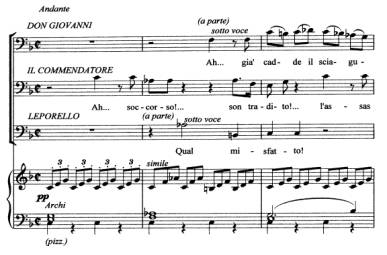
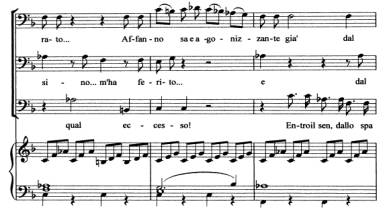
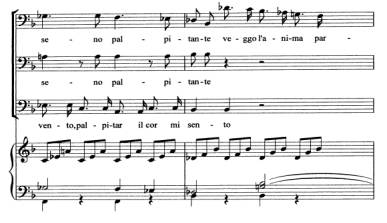
W. A. Mozart: Don
Giovanni, K 527, Act One, Scene One,
mm. 176-183
The likeness
between this scene and the first
movement of Beethoven’s
Sonata Op. 27, no. 2 is unmistakable:

L. van Beethoven:
Sonata in c-sharp minor, Op. 27,
no. 2 - I. Adagio sostenuto - mm.
4-7
In Mozart, the calm ostinato of
the accompaniment portrays the silvery
quality of the moonlight. The sense
of mystery provided by the unassuming
stillness of the background establishes
a paradox with this tragic, fundamental
episode in the opera. While in Beethoven’s
opening movement of the Moonlight a
sense of tragedy being consumed might
not be perceived with equal power,
the color and texture achieved are
certainly suggestive of the nocturnal
atmosphere depicted by the accompaniment
in Don Giovanni’s scene.
Don Giovanni or not, it is the German
poet and music critic Ludwig Rellstab
who nicknamed the Sonata Moonlight.
The moon reflecting on Lake Lucerne
was supposedly the stirring image
about which Rellstab wrote in the
1830s, less than a decade after Beethoven’s
death.
To what extent
was Chopin influenced by this first
movement when composing his Nocturne
in c-sharp minor, Op. 27, no. 1,
written in 1835? Even though Chopin
was certainly unfamiliar with Rellstab’s
description of the Moonlight at the
time, doubtlessly there are strong
parallels that can be drawn between
the two pieces. Not only do they
offer nocturnal depictions: they
also share the same opus number,
key signature, accompaniment in triplets,
and dotted eighth-note rhythm in
the right-hand melody. Chopin occasionally
assigned this Sonata to his pupils,
and it would not be surprising that
introducing all these mutual elements
in his Nocturne had been a premeditated
decision on his part.
A recent
article by Dr. Nigel Nettheim shows
how Chopin’s Ballade
in f minor likely derives from material
found in works of Bach and Beethoven.³ Dr.
Nettheim drew parallels between the
elaboration of the thematic material
in the main theme of the Ballade
and the Prelude in b-flat minor from
the first volume of Bach’s Well
Tempered Clavier, and how subsequent
episodes in the Ballade clearly point
to specific melodic and cadential
components found in the same piece.
Elements from Beethoven’s Sonata
in f minor, Op. 57 seem also to have
deeply affected the coda of the Ballade
(perhaps not coincidentally in the
same key). The same article implies
that thematic material from the first
movement of this Beethoven Sonata
may have served as a model for the
closing movement of Chopin’s
Preludes, Op. 28:
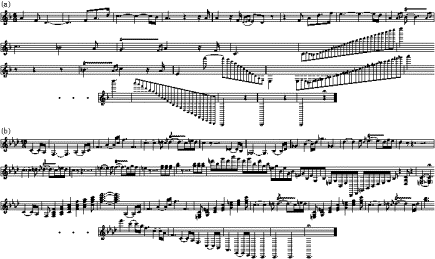
A comparison
between Chopin’s
Prelude in d minor, Op. 28, no. 24
(a) and Beethoven’s first movement
of the Sonata in f minor, Op. 57
(b) from Dr. Nigel Nettheim’s
article (with kind permission)
Striking similarities can be detected
between the works of Chopin and Mozart
as well. In the middle section of
the Largo from the Sonata
in b minor, Op. 58, for instance,
the eighth-note figuration unquestionably
resembles the writing in the B section
of Mozart’s a minor Rondo,
K.511:
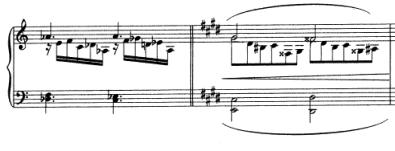
Mozart: Rondo in a minor, K. 511
- m. 46 (left) / Chopin: Sonata in
b minor, Op. 58 - III. Largo - m.
77 (right)
How much
of it could have been unconscious?
A significant case was pointed out
by Ernst Oster, who concluded that
the reason why Chopin never published
the Fantaisie-Impromptu in c-sharp
minor (published posthumously as
Op. 66 by Julian Fontana) was that
it almost embarrassingly showed its
derivation and motivic manipulation
from the third movement of Beethoven’s Moonlight Sonata.�
THEATRICALITY
AND FORM IN CHOPIN’S
FANTAISIE, OP. 49
If composers
of the past deeply affected Chopin’s
works, whether or not accidentally,
we could hypothesize that in the
exposition of the Fantaisie in
f minor Chopin drew inspiration
from this same movement of the Moonlight.
A rather unorthodox approach to Sonata-form
was employed in this presto agitato,
where the second thematic block in
the exposition appears in the key
of g-sharp minor instead of following
a conservative route that would modulate
to the relative key of E Major. Beethoven
introduces a relation between themes
that is somewhat off balance, mirroring
the harmonic layout of a movement
written in a major key, where the
second thematic group conventionally
appears at the dominant. In this
movement, the dichotomy established
between the two thematic elements
is preserved, highlighting the structure
in a fairly conventional way. However,
the harmonic scheme introduces this
strongly ambiguous element, appropriately
justifying the piece’s subtitle Sonata
quasi una Fantasia in some of
its idiosyncratic design.
Between 1841 and 1842, Chopin completed
some of his greatest achievements.
The Ballades in A-flat major, Op.
47, and f minor, Op. 52; the Mazurkas
Op. 50; the Impromptu Op. 51; the
two Nocturnes, Op. 48; the Prelude,
Op. 45; and the Fantaisie Op. 49;
all these works were the result of
an extremely productive and inspired
period in which he enjoyed overall
good health, certainly stimulated
by the beautiful summers spent at
Nohant with George Sand. Despite
such a consistent level of quality
throughout those two summers, Chopin
failed to find satisfaction in his
Fantaisie in f minor. After months
endlessly spent refining it, with
reluctance he sent it to the publishers.
A few years
earlier, with the Ballade in g
minor, Op. 23, finished in 1835
and published in 1836, Chopin opened
the road to a new conception of Sonata-form,
with a new abridged version of a
structure that was feeling the burden
of time. It is commonly believed
that it took him nearly three years
to feel content with it (although
an unsolved mystery envelops the
gestation of the piece: based on
detective work done on the paper
that Chopin was using at the time,
some scholars concluded that it could
not have started any early than 1834).
Chopin found a solution to an otherwise
old-fashioned formula by eliminating
a full recapitulation: creating a
strong climactic point in the development,
he poured forth directly into the
second theme, bypassing the re-exposition
of the first thematic block. Soon
after the Ballade, this new convincing
intuition was captured again in the
first movement of the Sonata in b-flat
minor, op. 35. Chopin used almost
exactly the same identical procedure
in the opening movement of his third
Sonata in b minor, Op. 58, and ended
his life as a composer by sending
to the prints a work that represented
his final monumental effort, the
Sonata for Cello and Piano, Op. 65,
where the same concept was followed
once again in the first and fourth
movements. This innovative conception
had already been used in the 18th
century, but its occurrence was extremely
rare. We find an example of it in
the first movement of Mozart’s
Sonata in D Major, K311.
His two Piano
Concerti were a different matter
altogether. The stylistic blueprint
of the Classical Concerto with a
double exposition was pursued by
a nineteen-year-old who was trying
to affirm himself as an itinerary
virtuoso. Structural originality
was not an object. What are the motivations
that pushed Chopin to destroy a tradition
that had lasted for over sixty years?
Was it the fact that it became a
stale practice in need of a fresher
approach? Was he trying to create
a trademark that would set him apart
as a revolutionary, an iconoclast?
In
this respect, the Fantaisie Op. 49
somewhat represents a big anomaly
in Chopin’s output. After abandoning
the strict Sonata-form for nearly
a decade, Chopin resuscitated it
in the Fantaisie, presenting a configuration
that featured a full recapitulation
in a piece that, if living up to
its expectations, was supposed to
employ a free form! Yet, if the structure
recuperates old archetypes, what
needs to be considered ‘fantastic’ in
this case is the highly unconventional
harmonic layout, which presents a
fairly complex path. In the Fantaisie,
Chopin reaches heights never accomplished
before, embodying extraordinary qualities
drawn both from the present and the
past.
In Chopin’s
Fantaisie, Beethoven’s
revolutionary approach is preserved
and expanded in the exposition, where
the dialectic between the two thematic
groups is less radical because of
the melodic nature that unifies their
character. As the piece unfolds,
we also recognize traits that are
grounded in the operatic milieu:
there are two Marches, a Chorus,
a Recitativo. There is even an Intermezzo.
Furthermore, the harmonic layout
is based on relations of minor and
major thirds, playing a fundamental
role by evoking harmonic implications
often found in coeval Italian and
French arias. The Fantaisie was definitely
not an attempt to contribute to the
tradition of the Fantasia Drammatica,
a genre which Liszt and Thalberg
had introduced as of the early 1830s.
Chopin had kept himself rather distant
from that world, making brief, shy
appearances in it with the Duo
Concertante on Themes from Meyerbeer’s
Robert Le Diable for cello
and piano, written in 1831-32,
and, peripherally, with a Nocturne-like Variation
on the March from I Puritani by
Bellini of 1837, which found
inclusion as no.6 in Liszt’s Exameron.
In
the Fantaisie, transitional episodes
based on patterned arpeggiations
are used as linking elements between
sections and afford quite extravagant
modulations based on chromatic implications.
This kind of writing consents extreme
harmonic freedom and is stylistically
derived from formulas that most likely
Chopin employed in his improvisations.
It is in Eugene Delacroix’s
journal that we read about Chopin’s
extemporary playing being bolder
than his compositions, both in style
and character, his actual pieces
being mere distillations of his improvisations.
We surely find that boldness in these
arpeggiated figurations, virtuosic
in nature, whose inclusion in the
piece balances out the strictness
of the Sonata-form, re-establishing
contact with the idea of capriciousness
that one would assume to find in
a piece entitled ‘Fantasy’.
An
unexpected element occurred to me
only a few years after I had learned
the piece: the relation between the
austere opening in f minor and the
section in the key of B Major marked Lento,
sostenuto, which we could
define in operatic terms as an
Intermezzo. B breaks the octave
of F in two perfect parts, creating
a tension that surpasses that of
the simple dichotomy dominant-tonic,
frequently used to create harmonic
contrasts. It is the augmented fourth,
also known as tritone – Diabolus
in musica, as it was called
in the Baroque era. How ironic that
a tritone would distance this religious,
hymn-like Intermezzo from the severity
of the introduction! Stemming from
the Lydian mode and being a rather
common interval in Polish folklore,
one is only left wondering whether
this way of using the augmented fourth
in the Fantaisie was a coincidence.
I
mentioned how Chopin’s Fantaisie
embodies qualities that are drawn
both from the past and the present.
If stylistic elements were borrowed
from the contemporary Italian and
French Opera, form and balance link
the work to past traditions. In Chopin,
however, everything is in constant
transformation, even the reinvention
of a strict form as it was employed
in the 18th century. If the exposition
followed the harmonic structure found
in the third movement of Beethoven’s
Sonata, Op. 27, no. 2, the recapitulation
seems to backtrack to earlier years
and possibly follow the model presented
by the first movement of Mozart’s
Sonata in C Major, K. 545, which
features a recapitulation at the
subdominant. In Mozart, this procedure
was utilized conveniently, given
that the conciseness of the movement
did not allow much room for harmonic
and structural flexibility. In the
Fantaisie, the form is extended to
the degree that this route would
be completely unnecessary. Proposing
a literal recapitulation at the subdominant
(b-flat minor) led to the placement
of the correct tonal area (f minor)
for the second theme. However, because
of the modulation to its relative
major in the exposition, this made
the piece end in the ‘wrong’ key – A-flat
Major. Chopin had experimented with
a similar formula in the Scherzo,
Op. 31, where nonetheless the b-flat
minor of the opening plays such a
secondary role throughout the outer
sections that the relative major
prevails and imposes itself as the
featured key.
HARMONIC TENSIONS
While considering
the tritone relation employed in
the Fantaisie between the main
body of the piece and the ‘Intermezzo’ in
B Major, it occurred to me that a
similar strategy is utilized in the
Ballade in g minor, Op. 23. The scheme
is ingenuously articulated, with
a mirror-like architecture that bases
its pillars on three fundamental
keys:
g minor - E-flat
Major - (a minor) - A Major - E-flat
Major - g minor
The abridged recapitulation
pours forth into the second theme,
re-proposing E-flat major with a
long peroration that leads to the
extended coda in g minor. The presence
of a tritone in the middle, breaking
the piece in two, enhances A Major
as an extremely remote place, furthering
the sense of anticipation as the crescendo to
the development, based on a pedal
point, builds up the dynamic tension
to the fortissimo.
We previously
saw how in the Scherzo in b-flat
minor, Op. 31 the opening key quickly
turns to its relative major, D-flat,
closing the A section. Unexpectedly,
the Trio opens in A Major, enharmonically
a major third apart, compromising
the assurance that relating keys
conventionally provide:
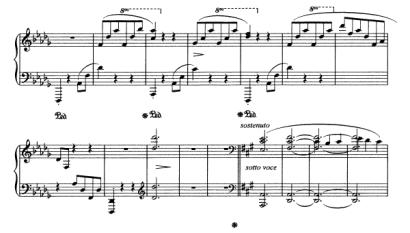
F. Chopin: Scherzo in b-flat minor,
Op. 31 – mm. 253-268
The key
of A Major abruptly modulates to
c-sharp minor, parallel minor of
D-flat Major. In this Scherzo, the
shifts to new keys are often harsh
and unexpected, making the spectrum
of emotions much more defined. I
believe not coincidentally, the introduction
of the key of E Major (dominant of
A Major) via its relative (c-sharp
minor) in the Trio is used to create
a harmonic tension that is based
again on a tritone relation with
the opening key of b-flat minor,
showcasing brilliant waltz-like passagework
that is reminiscent of the outer
sections.
In the Polonaise
Fantaisie in A-flat Major, Op. 61,
third relations are used throughout
the work, creating unforeseen harmonic
situations enhancing the dichotomy
between thematic materials. The key
of the second major idea, B Major,
is already presented enharmonically
as C-flat Major in the opening measure
of the piece:
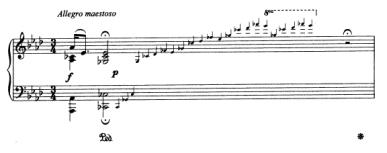
F.
Chopin: Polonaise Fantaisie in A-flat
Major, Op. 61 - m. 1
The
startling opening in a-flat minor
allows Chopin to use C-flat Major
as its relative major key or its
mediant, establishing already a relation
of thirds within the first measure
by treating the tension either as
VI-I or I-III. B Major will also
be used as the key proposing a brief,
fragmented recapitulation. Following
the harmonic path presented at the
beginning, the first measure of the
recapitulation (m. 214) features
the key of D Major, a tritone apart
from the key of the opening:
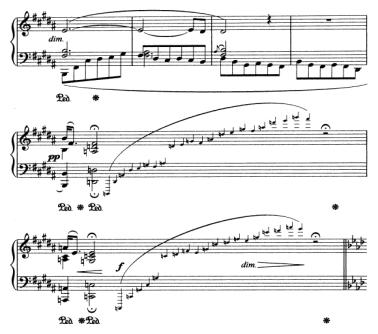

F.
Chopin: Polonaise Fantaisie in A-flat
Major, Op. 61 – mm.
208-220
What
follows is a chain of harmonies that
certainly implies a close relation
(A Major in measure 215 as the dominant
of D Major in the previous measure,
and C Major in the same measure as
the dominant of f minor in measure
216), but that are introduced in
a scattered manner, producing a state
of melancholy and desolation caused
by kaleidoscopic changes of colors
in pianissimo,
with a sudden forte urging
from the abysses (m. 215), immediately
vanishing into thin air.
Creating
striking harmonic contrasts was a
device used already in the 18th century,
mostly to create strong shifts in
color between movements of large
works. This is present early in Beethoven’s
output: in the Trio in G Major, Op.
1, no. 2, the Adagio movement is
in E Major; in the Sonata in C Major,
Op. 2, no. 3, the second movement,
Adagio, is also in E Major, distancing
the listener from a predictable relation
of dominant or subdominant. The same
procedure is adopted in his Piano
Concerto in C Major, Op. 15, where
the middle movement is in A-flat
Major. In the Piano Concerto in E-flat
Major, Op. 73, the second movement
is written in B Major (enharmonically
C-flat, a major third below E-flat).
Beethoven brings this dialectic even
further by using it within the first
movement of the Sonata in C Major,
Op. 53, where E Major appears in
the exposition as the key of the
second thematic group. The same operation
is used in his last Sonata, Op. 111,
where the second theme in A-flat
Major in the first movement is based
on a dominant pedal point. In the
Piano Concerto in G Major, Op. 58,
after a brief, intimate five-measure
introduction of the piano ending
at the dominant, the orchestra introduces
the same material, this time in B
Major.
Haydn
had started using this approach a
few years earlier: in his Trio in
G Major, Hob. XV/25, the slow movement
is in E Major (a possible harmonic
model for Beethoven’s
Trio Op. 1, no. 2?); in the Sonata
in c-sharp minor, Hob. XVI/36, the
middle movement is scored in A Major.
Years later, Haydn brings this practice
to an extreme in his Sonata in E-flat
Major, Hob. XVI/52, by writing the
middle movement in the far key of
E Major, emphasizing a strong attraction
to an ideal Neapolitan harmony found
already in the recapitulation of
the first movement.
Coloristic
shifts between movements of a large
work are present in Chopin as well:
the Scherzo from the b minor Sonata,
Op. 58 is in E-flat Major (enharmonically
D-sharp, a major third away from
B), a key that was already introduced
momentarily in the first movement
in the bridge between the two thematic
blocks of the exposition, functioning
as a pseudo-Neapolitan of the second
subject in D Major. The appearance
of E-flat Major again in the fourth
movement of this Sonata confirms
Chopin’s
astute layout of harmonic schemes
for extended structures, a skill
doubted for a long time by many opinionated
scholars who discussed Chopin’s
handling of large forms. Curiously,
in the Sonata in b minor, the dominant
of the main key (F-sharp Major) is
avoided throughout the entire work
as a main harmonic center, with the
exception of a brief momentary appearance
as the featured key in the first
appearance of the second theme in
the Rondo-Sonata movement.
Robert Schumann also used relations
of thirds to create paths within
multi-movement compositions. Kreisleriana,
Op. 16, comes to mind, where a chain-like
structure is superimposed to a sequence
of third relations: the opening movement,
in d minor, proposes a middle section
in B-flat Major; the same key is
used for the second lyrical movement
of the set; the second Intermezzo
of this movement is in the key of
g minor, which is also the key of
the following movement; the middle
section re-proposes the key of B-flat
Major, which is also the opening
key of the fourth movement; the middle
section is in B-flat Major, but features
a strong attraction to g minor, the
key of the fifth movement. The chain
pattern continues uninterrupted until
the end, and the set will even find
a sense of unity with the opening
by echoing the d minor of the Prelude-like
movement in the second Intermezzo
of the concluding piece. Schumann
extensively uses third relations
between movements of large works,
such as in the Fantasie in C Major,
Op. 17, with the second movement
in E-flat Major. The Piano Concerto
in a minor, Op. 54, features the
key of F Major for the second movement.
In Chopin’s Barcarolle, Op.
60, the relation of thirds is certainly
employed, but here the harmony shifts
by using substantial mode changes.
The opening key of F-sharp Major
is preserved quite consistently throughout
the first few pages, with somewhat
conventional transitions to its relative
minor (a minor third below) and its
dominant. F-sharp Major suddenly
turns into f-sharp minor, justifying
the sudden shift to its relative,
A Major (a minor third above), which
becomes the predominant key for a
substantial portion of the piece.
Through an extended section that
features some harmonic instability,
we land in C-sharp Major, beginning
a long peroration that returns to
the key of F-sharp Major (C-sharp
Major being its implied dominant).
This procedure seems to be relatively
simple, yet it reveals a carefully
planned scheme that supports the
Barcarolle’s unmistakable folk
implications. This simplicity also
reveals Chopin’s affinity to
operatic archetypes consistently
found in his works: the duet-like
melody in thirds and sixths (perhaps
a model for Sous le dôme épais,
the Flower Duet from Delibes’ Lakme?)
and the sudden modulations to relative
or parallel keys. The section marked sfogato might
also give us a glimpse of operatic
allusions, where the writing is reminiscent
of vocal qualities typical of the soprano
acuto.
SFOGATO?
Playing Chopin’s Barcarolle
for Russell Sherman radically changed
my vision of the piece: he encouraged
me to find the identity of the alto
voice, insisting that it was a much
needed element in the enunciation
of the melody, so as not to attribute
all the ‘responsibilities’ to
the soprano. “Chamber music”,
as Sherman would describe it, referring
to the timbric independence of each
line as of that of instruments of
different nature. Crucial to my understanding
of this essential factor was time:
only after years did I feel gratified
by the degree of confidence that
I had achieved in performance.
Another revelation
about the piece came when Sherman
asked one day, “Roberto,
since you are Italian… what
exactly does sfogato mean?”.
I mumbled “Being able to finally
say or do something after keeping
it inside for a long time”.
That was the closest paraphrase of
the term I was able to offer,
as I had never paid much attention
to a possible translation of it.
Looking somewhat puzzled, Sherman
proceeded to illustrate his account
of it, which was closer to “sfocato” -
in Italian, ‘out of focus’. “In
a mist”, he suggested, given
the silvery sound he so magically
produced.
A few days
later, I was leafing
through André Gide’s Notes
on Chopin, which I
had read somewhat superficially as
a teenager. Gide compared Chopin’s
works to Baudelaire’s Fleurs
du mal, assigning a whole new
meaning to the word sfogato and
its interpretation in this specific
instance:
Has any other musician
used this term, felt the desire,
the need to indicate this breathing
openness, this breeze which, interrupting
the rhythm, intervenes unexpectedly
to refresh and perfume the middle
section of the Barcarolle?
I was perplexed. Chopin was the
first composer ever to employ the
word sfogato in a score,
but I found the idea that he
might have misused it tempting. The marking,
which appears in measure 78, has been
puzzling many, and unless Chopin
confused sfogato with ‘sfocato’,
I found difficult to believe that he would
get so descriptive of such an intense,
emotional state:
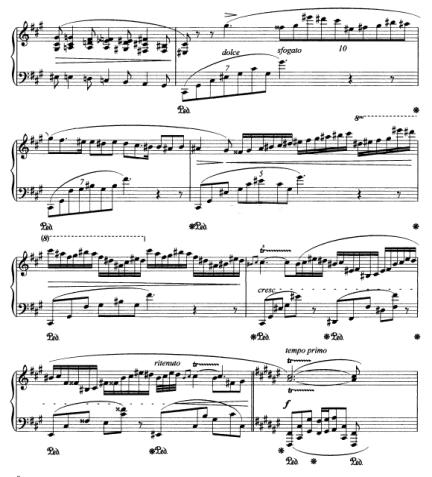
Example P.8 - F.
Chopin: Barcarolle in F-sharp Major,
Op. 60 - mm. 77-85
Certainly, ‘in
a mist’ is a
plausible interpretation. Perhaps
Sherman had a point. Maybe Chopin
just misspelled an Italian word,
hearing it pronounced by Countess
Carlotta Marliani in her colorful
Tuscan accent, where hard Cs seamlessly
turn into guttural Gs. Nevertheless,
I was quite keen on the notion
that Chopin had something in mind
that differs from what we normally
imagine in this passage. Perhaps
he borrowed the word from a common
vocal term that indicates a very
high acrobatic soprano voice,
with light, airy tone - the
so called soprano acuto sfogato.
In his youth, Chopin had used other
vocal terms in his pieces in order
to suggest an emotional state. Is sfogato a
possible allusion to the lightness
and airiness of the passage? To be
played in the style of a soprano
acuto sfogato? Did André Gide
have it right?
I recently looked
up sfogato on
the internet. Here is what I found: ‘Unburdened’,
which somehow made a strong case,
especially in light of the harmonic
function and the emotional release
of that specific passage; ‘Relieving
the heart with the utmost expression’ (courtesy
of the Dutch Piano Duo Sfogato),
which was certainly better than
the translation I had provided for
Sherman: it aptly serves the
nature of the dolce that
accompanies the melody, giving
its intonation a full, inebriating
quality, floating on the rich
texture of overtones generated by
the left hand. I am still not completely
certain that Chopin used the word
being fully aware of its meaning.
Certainly, the Piano Duo Sfogato provided
an accurate translation of the term –or
at least the closest one.
õ õ õ
Some months ago, my friend Valerie
provided quite a wonderful description
of the Barcarolle (and the sfogato passage),
which I will selflessly share:
“Chopin wrote
to his family in July 1845:
‘I hope Paris
will have good weather for this month’s
celebrations. This year [...] it
is to be illuminated. On the Seine,
this summer, speculators in human
whims have hit on a new notion. There
are several vessels, very smartly
got up, and gondolas in the Venetian
style, that ply in the evenings.
This novelty delights the boulevard
crowds, and it is said (I have not
seen it myself) that great numbers
of persons go out on the water’.6
The idea of writing
a Barcarolle came to Chopin around
this period. It is a rich, multi-voiced
work, where contrapuntal ideas are
brought to such a new level that
one needs to re-evaluate the concept
of measure as a restraining factor.
There are instances, such as in the
section marked dolce sfogato,
where Chopin introduces a voice in
the left hand which, by means of
subterranean devising, manages to
descend while remaining virtually
outside of the measure, as if it
were sinking gossamer, delicately
masked by voluptuous meanderings
in the right hand, nevertheless reaching
us on a subconscious level.
Rare is the interpreter who can find
all of the voices in the Barcarolle
and give them more than effective
pianism, but arrive at the sort of
feelings which these interwoven lines
are intended to evoke. It is
a monumental achievement on many
levels. Friederich Nietzsche, whose
heart had room for music, considered
the Barcarolle Chopin’s best
work.
Everything is here: the heave, the
ripples, the glints and shadows,
the imagined whiff of canals and
gondoliers alike, a playful suggestion
of danger, of sense of unity between
sensuality, intrigue, rightness and
joy. Its cosmic quality lifts us
into a sublime, suspended, blissful
state, not quite as a loss of innocence
but as the most delicate hint of
the possibility: civilized consummation
through non-consummation – a
state of eternal postponement – of
dwelling at the brink end, settling
for that as an end in itself”.
Valerie also pointed out that “Chopin
had a head for numbers. He would
have been amused to learn the price
of a gondola today: between
fifteen and twenty-five thousand
U.S. dollars!” [That was before
the conversion to Euros and the tragic
fall of the dollar]
1) James H. Johnson, “Sincerity
and Seduction in Don Giovanni”, “Expositions”,
Vol. 1, no. 2, Fall 2007 (September),
49
2) Translation by Roberto Poli
3) Nigel Nettheim, “The Derivation
of Chopin’s Fourth Ballade
from Bach and Beethoven”, “The
Music Review”, Vol. 54 No.
2, 1993, 95-111
4) Ernst Oster, “The Fantaisie-Impromptu:
A Tribute to Beethoven” from
Aspects of Schenkerian Theory (New
Haven: Yale University Press, 1983),
Appendix, 189-207; original article
published in Musicology 1 (1947),
407-429
5) André Gide, Notes sur
Chopin (Paris, France: L’Arche,
1948), 31 - Roberto Poli, translation
6) Ethel Lillian Voynich, Henryk
Opienski, Chopin’s letters (Mineola,
NY: Dover Publications, 1988), 289


|